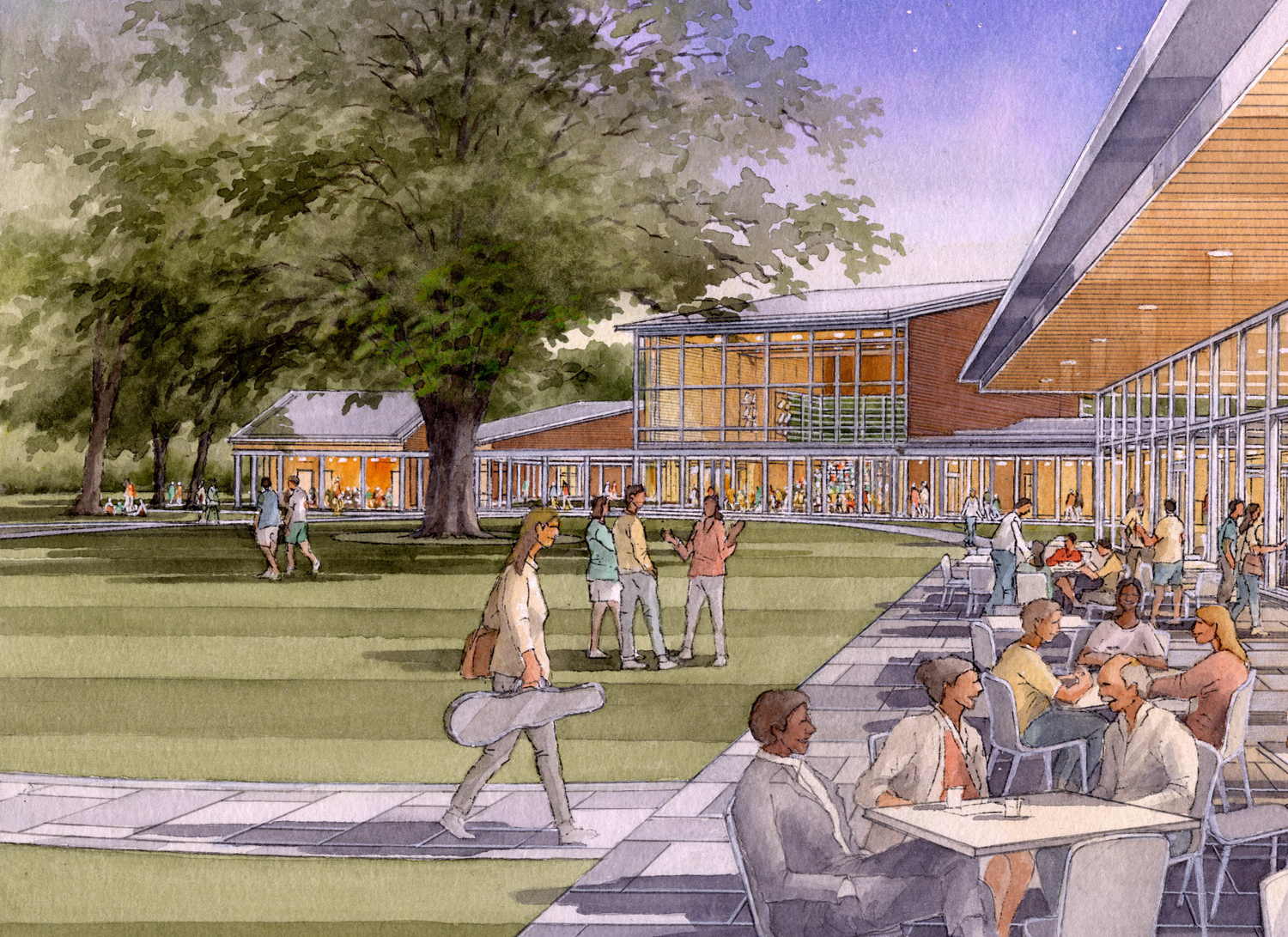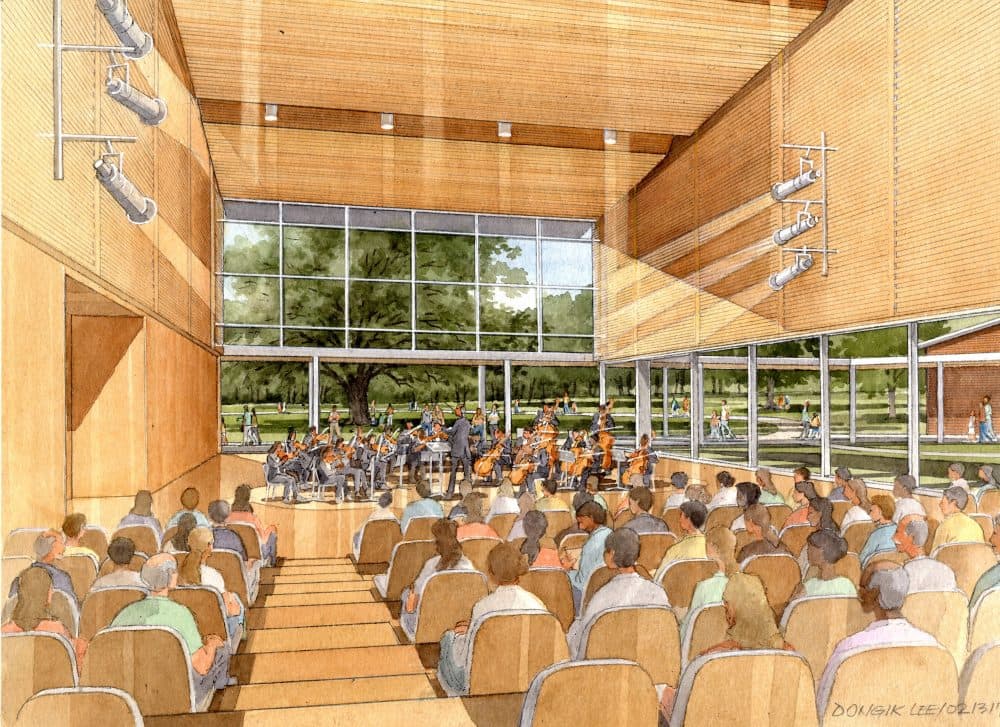Advertisement
BSO Invests $30 Million In Tanglewood Expansion

The Boston Symphony Orchestra announced Tuesday plans for some major additions to its Tanglewood campus.
The BSO hasn’t made significant changes to its rolling, verdant, summer home in the Berkshires since Ozawa Hall was constructed more than 20 years ago.
BSO managing director Mark Volpe points to that structure, named for former, longtime music director Seiji Ozawa, as the one of the "threshold moments" at Tanglewood — third behind BSO music director Serge Koussevitzky’s 1940 formation of the competitive summer music academy now known as the Tanglewood Music Center and his creation of its annual classical music festival in 1937.
“So this this is the fourth transformational moment in the history of Tanglewood,” Volpe said of the expansion. “It involves building four structures — three that will have significant programming in them.”
The planned complex of four pavilions was designed by Boston architecture firm William Rawn Associates. Volpe says the much-needed spaces will provide state-of-the-art facilities for more performances, practicing, dining, mingling and learning — especially for the music fellows who study at Tanglewood during the summer.
“We are, candidly, in need of more space — rehearsal space, coaching space — for the students of the Tanglewood Music Center,” Volpe explained. “We want to attract the best students from throughout the world to come to Tanglewood.”
According to the BSO’s description, the multi-purpose pavilions will be situated on the grounds surrounding a 100-foot red oak tree.
Studio 1 — the largest building — will be used for rehearsals and mentoring along with performances in a space that can seat 200. Its acoustics are said to be top notch, and the room will be adjustable so it can be "tuned" for smaller recitals, chamber concerts and larger ensembles.
Another architectural element cited is a full glass wall that will serve as a backdrop for the stage, offering views of the Berkshires beyond the musicians. Retractable, raked floor seating is also part of the design.
Studios 2 and 3 will be smaller and can be used for more intimate performances and lectures accommodating 60-90 people.
There will also be a new 150-seat café designed to encourage audience interaction with the musicians.
Tanglewood currently attracts about 350,000 visitors annually.

BSO music director Andris Nelsons expressed his excitement for the upcoming transformation.
"The great BSO Music Director Serge Koussevitzky had tremendous foresight in recognizing the potential of Tanglewood as a beacon of inspiration for all those visiting and experiencing its many gifts, so our investment in its future is essential as we continue to expand Tanglewood's many wonderful offerings," Nelsons said in a statement.
"Tanglewood’s new building project will provide the best possible atmosphere for the talented Fellows of the Tanglewood Music Center to learn and grow on their path to becoming the next generation of musicians, earning their spots in the world's great orchestras, concert halls, and opera houses," Nelsons added.
In addition to benefiting the young summer students, the expansion will play a big role in Tanglewood’s fledgling adult education program called the Learning Institute, which is geared toward the wave of retiring baby boomers that includes music lovers who curious and living longer.
“The new Tanglewood Learning Institute starts a new chapter in the orchestra's remarkable history by connecting our audience to our music-making in new ways,” Nelsons also said.
Volpe elaborated during an interview, saying on weekends the BSO will be able to plan more ambitious, intense activities for the program with in-depth lectures on, for example, the role of music in film. These could include venerable speakers like Hollywood composer and Boston Pops Laureate Conductor John Williams and directors Steven Spielberg or Martin Scorsese.
The Berkshire community will also benefit from the expansion, according to Volpe, because the new buildings will be weatherized and usable year-round. When the orchestra heads back to Boston at the end of the summer, locals will be able to host their own events on the campus.
“It adds significant inventory,” Volpe said, “but it actually can be a great off-season civic resource.”
The managing director said the BSO has secured about $30 million in funding to move forward with the construction, but still aims to raise money to endow the expansion and to support a new horticultural and landscaping initiative for Tanglewood’s 524 acres.
When asked about the overall concept driving the additional spaces, Volpe pointed to the sports industry and how stadiums and ball parks have evolved.
“A game isn’t just a game — it’s everything around the game,” he said.
The BSO will break ground on its new complex of buildings at Tanglewood this summer with the goal of opening to the public in 2019.
